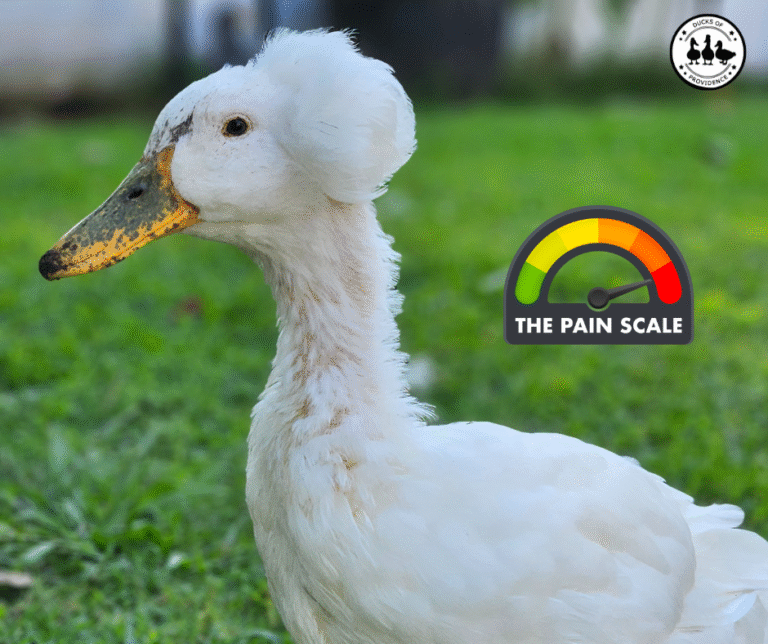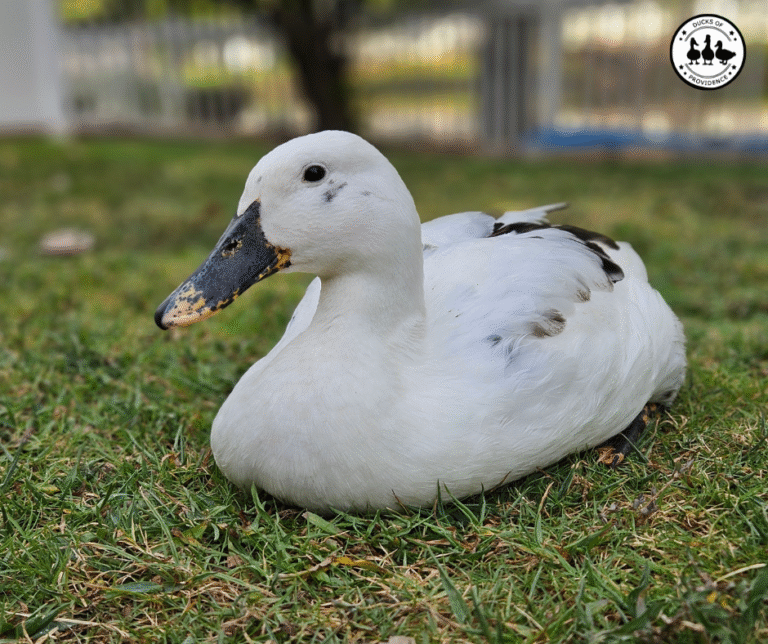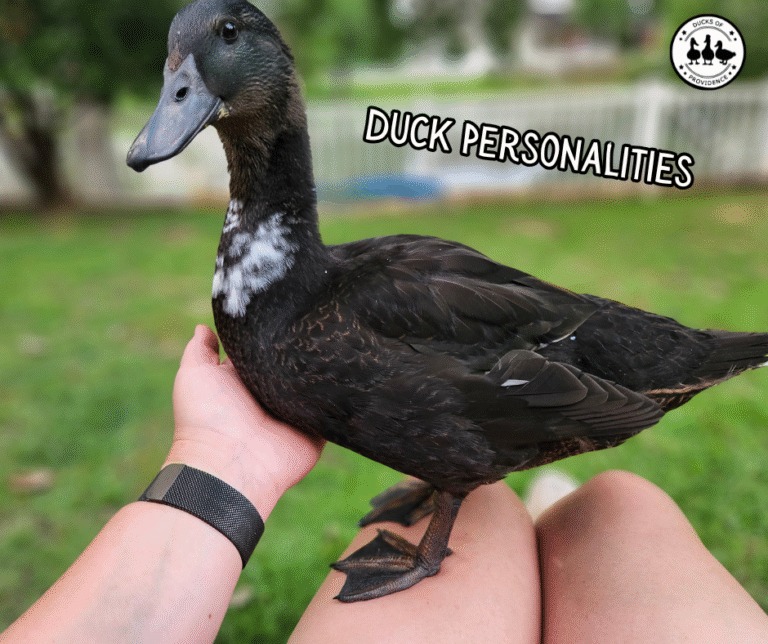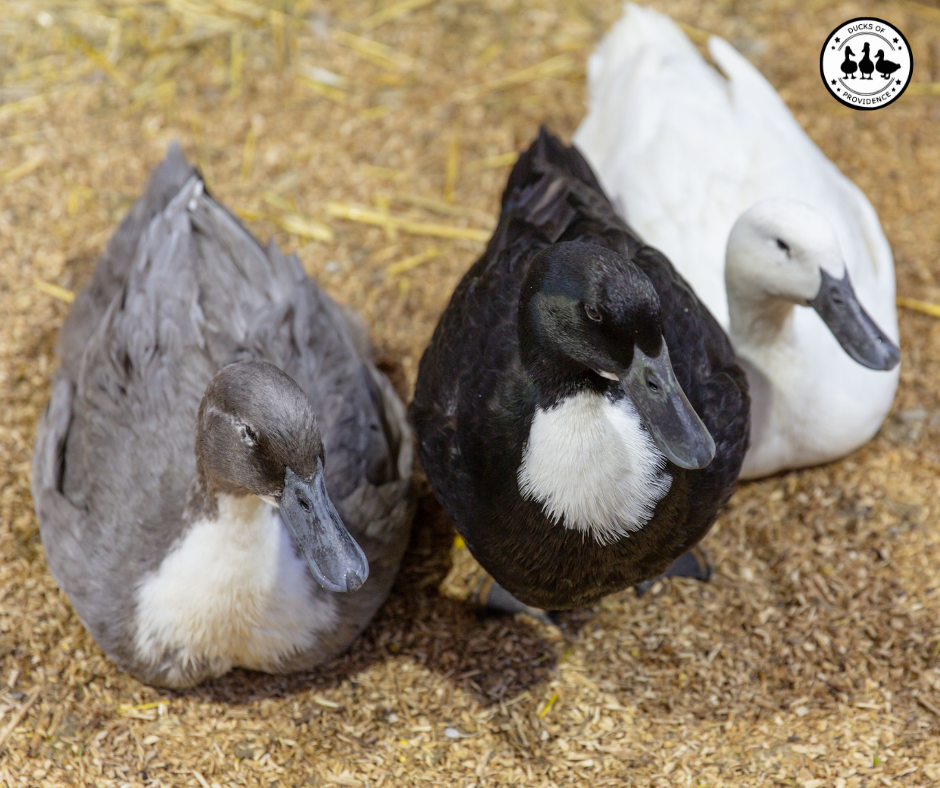
Swedish Ducks: Calm, Hardy, and Strikingly Beautiful
If you’re looking for a pet duck breed that’s hardy, beautiful, and easygoing, Swedish Ducks might be the perfect fit for your flock. Known for their striking blue plumage and gentle temperament, Swedish Ducks are an excellent choice for both new and experienced duck keepers. These medium-sized ducks are cold-hardy, relatively quiet, and enjoy human companionship—making them ideal for backyard setups and smaller properties.
In this post, we’ll take a closer look at the Swedish Duck’s history, appearance, behavior, egg-laying capabilities, and care requirements. Whether you’re adding to an existing flock or just starting out, you’ll learn why Swedish Ducks are such a beloved breed among pet duck enthusiasts.
Ducks of Providence is free, thanks to reader support! Ads and affiliate links help us cover costs—if you shop through our links, we may earn a small commission at no extra cost to you. Thanks for helping keep our content free and our ducks happy! 🦆 Learn more
Breed Overview Table
| Trait | Details |
|---|---|
| Origin | Sweden (early 1800s) |
| Size | Medium |
| Weight (Male/Female) | 6.5–8 lbs / 5.5–7 lbs |
| Egg Production | 100–180 eggs/year |
| Egg Color | White to tinted |
| Temperament | Calm, friendly, slow to mature |
| Cold/Heat Tolerance | Very cold-hardy, moderate in heat |
| Flying Ability | Limited |
| Lifespan | 8–12 years with proper care |
| Broodiness | Occasional |
| APA Status | Recognized |
| Color Varieties | Blue (most common), Black, Splash |
History and Origin
The Swedish Duck, often referred to as the Blue Swedish, originated in Sweden in the early 1800s, particularly in the regions of Pomerania and southern Sweden. This breed was developed as a reliable farm duck—valued for both its meat and egg production, as well as its ability to withstand harsh northern climates. Their utility and resilience made them a popular choice among small farmers and homesteaders.
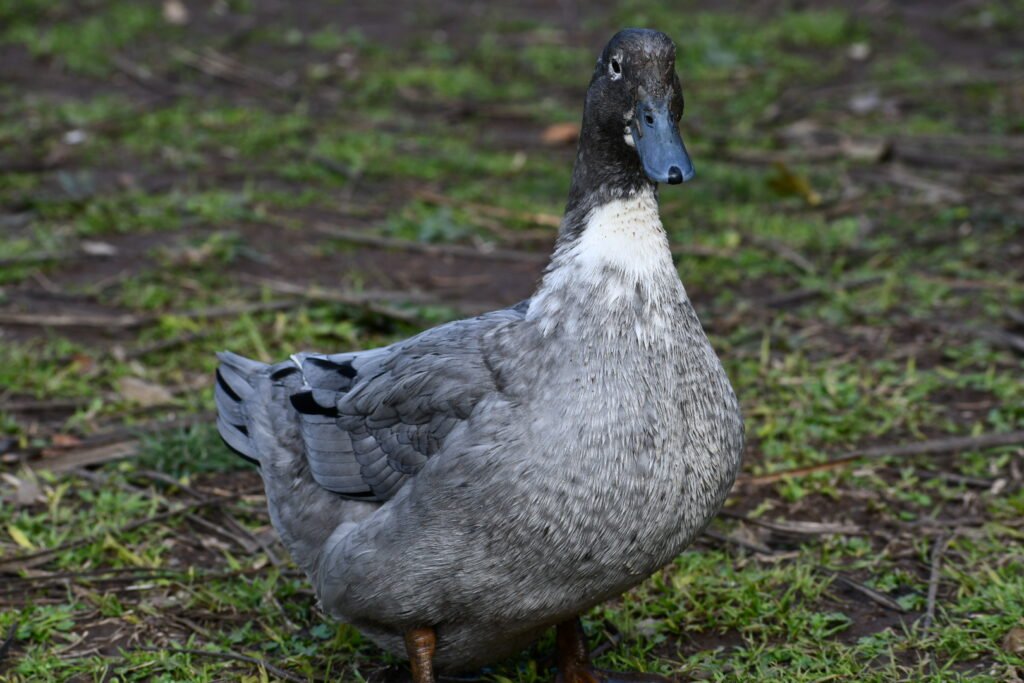
The Blue Swedish first made its way to the United States around 1884, where it gradually gained recognition for its calm temperament and eye-catching appearance. The American Poultry Association (APA) officially recognized the breed in 1904, cementing its place among classic heritage duck breeds in North America.
Today, while they’re not as common as commercial breeds like Pekins or Khaki Campbells, Swedish Ducks are appreciated by pet owners, backyard duck keepers, and small-scale breeders for their personality, durability, and unique appearance.
Appearance and Color Varieties
Swedish Ducks are admired for their classic upright posture, broad build, and soft, rounded features. They’re medium-sized ducks with a slightly elongated body and a full chest, giving them a balanced and sturdy look. One of their most recognizable features is the distinct white bib on their chest, which contrasts beautifully with their body plumage.
The most well-known and widely kept variety is the Blue Swedish, but due to the genetics of their color inheritance, Swedish Ducks come in three main color types:
🟦 Blue Swedish
This is the standard variety most people think of when they hear “Swedish Duck.” They have a rich slate-blue body, a crisp white bib, and may have white wing tips or facial markings. Their legs are typically dark gray to black, and their bills are bluish slate or dark gray. The blue coloration is due to a single dose of the dilution gene, which lightens black feathers to blue. Because blue doesn’t breed true, maintaining this coloration requires careful breeding.
⬛ Black Swedish
These ducks are the result of a blue-to-blue breeding pair producing a duckling with two copies of the black gene. Black Swedish ducks are often glossy black all over, also with the signature white bib, and their plumage may have a subtle greenish sheen in sunlight. They are just as hardy and gentle but are not recognized by the APA in the U.S.
⬜ Splash Swedish
This variety is the lightest in appearance and features a mottled or marbled mix of white and pale gray or bluish feathers, often giving them a dappled look. Splash Swedish are the product of blue-to-blue breedings and carry two dilution genes. Their soft coloring makes them stand out in a flock, and like the Black Swedish, they are not officially recognized in the U.S.
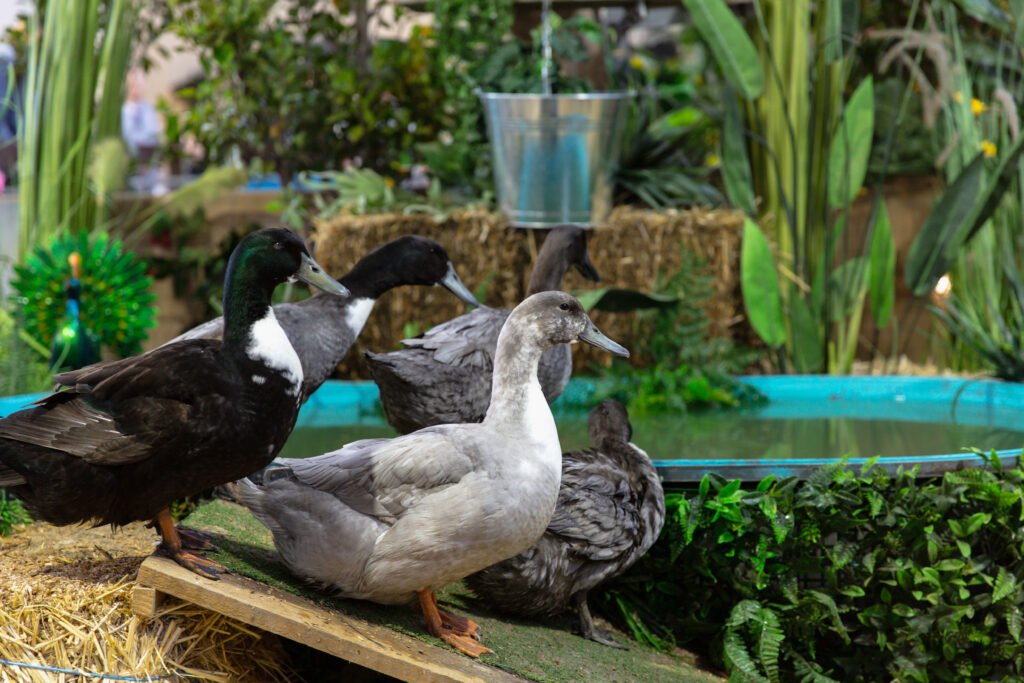
One fascinating feature of the Swedish Duck is the genetics behind its blue coloring. These ducks don’t breed true to color:
- Blue x Blue = ~50% Blue, 25% Black, and 25% Splash
- Blue x Black = ~50% Blue, 50% Black
- Blue x Splash = ~50% Blue, 50% Splash
This means that even within a single clutch, you’ll often see a mix of beautiful shades—adding to their charm but also requiring a bit more planning if you’re aiming for uniform colors.
General Physical Features of Swedish Ducks
Swedish Ducks are medium-sized waterfowl with a sturdy, well-balanced build and a graceful presence in the yard or on the pond. Their overall appearance is both functional and ornamental, combining solid farm duck utility with striking visual traits.
Size and Weight
- Drakes (males): Typically weigh between 6.5 to 8 pounds
- Hens (females): Slightly smaller, ranging from 5.5 to 7 pounds
They are robust without being overly bulky, which makes them easier to manage than heavier breeds like Pekins, yet still substantial enough for cold-weather resilience.
Body Shape and Posture
- Swedish Ducks have a horizontal, elongated body shape with a full chest and rounded back.
- They carry themselves with a slightly forward-leaning stance, which gives them a classic waddling gait.
- Their posture is more grounded and relaxed compared to upright breeds like Indian Runners.
Feathering
- Feathers are dense and water-resistant, helping them stay dry and insulated in wet or cold conditions.
- The texture is soft but firm, lying close to the body for a smooth silhouette.
Bill and Feet
- Bills are broad and flat, ideal for foraging and dabbling in shallow water.
- Bill color depends on the variety but is usually slate blue, black, or mottled gray.
- Legs and feet are dark gray to black, sturdy, and well-positioned for balance and support.
Eyes and Expression
- Swedish Ducks have dark, alert eyes that give them a calm, intelligent look.
- Their facial expression is often described as composed and gentle—matching their temperament.
Overall, Swedish Ducks are not only beautiful but also offer a touch of natural variation that can make every individual duck feel a bit special. Their striking appearance, combined with their peaceful nature, makes them a delightful addition to any backyard flock.
Temperament and Behavior
Swedish Ducks are often described as gentle, calm, and steady-natured—traits that make them especially well-suited for life as pet ducks. Unlike more active or flighty breeds like Indian Runners, Swedish Ducks tend to take life at a slower pace. They enjoy waddling around the yard, foraging in the grass, and lounging in the sun or shade with their flockmates.
Intelligent but Reserved
Swedish Ducks are fairly intelligent and observant but may be shy or cautious at first, especially if they weren’t handled frequently as ducklings. With gentle, consistent interaction, they usually become quite trusting. Many duck keepers report that their Swedish ducks follow them around the yard or quietly observe them from a few feet away.
They are not typically aggressive and rarely squabble with other ducks, making them a great fit for mixed flocks. That said, like all ducks, individual personalities can vary, and drakes (males) may show dominant behavior during the breeding season.
Great with Families
Thanks to their docile nature, Swedish Ducks are often a favorite among families with children. They’re less likely to nip or startle easily and tend to respond well to calm voices and slow movements. Their slower pace also makes them easier to supervise during outdoor time.

Relatively Quiet
Another advantage of this breed is their low to moderate noise level. While female ducks do quack (as all do), Swedish hens are not as loud or chatty as breeds like Pekins or Campbells. Drakes are typically even quieter, with a raspy, low-pitched voice.
This makes Swedish Ducks a suitable option for more urban or suburban environments, where neighbors might not appreciate a very vocal flock.
Ground-Oriented and Easy to Manage
Swedish Ducks are not strong fliers. Their body size and wing structure limit lift, so they rarely attempt to fly, especially in captivity. This makes them easy to contain with a modest fence or enclosed run, and you won’t have to worry about them flying off if startled.
They enjoy foraging, dabbling in water, and exploring, but they do so at a calm and unhurried pace—ideal for keepers who prefer a relaxed flock dynamic.
Egg Production
While Swedish Ducks aren’t known for being high-performance layers like Khaki Campbells or Welsh Harlequins, they do offer reliable, moderate egg production that’s more than sufficient for most pet duck keepers or small homesteads.
Average Laying Rate
On average, a healthy Swedish hen will lay between 100 to 180 eggs per year—that’s roughly 2 to 4 eggs per week, depending on the season, diet, age, and individual genetics. Their laying typically begins around 5 to 6 months of age, though this can vary depending on the time of year they were hatched.
Egg Appearance
Swedish Duck eggs are usually:
- White to cream-tinted, though some may have a light green or blue hue early in the season
- Medium to large in size
- Thick-shelled, making them excellent for handling and storage
Their eggs are great for baking and cooking, with the rich yolk that duck eggs are known for.
Factors Affecting Laying
Like all ducks, egg production in Swedish hens can be influenced by:
- Daylight hours: Egg production may slow or stop during the winter months unless supplemental light is provided.
- Diet: A well-balanced layer feed with sufficient calcium and added niacin (important for ducks) will help support healthy laying.
- Stress and environment: Overcrowding, predator pressure, or constant disturbances can affect laying patterns.
- Age: Peak production usually occurs in the first two to three years, with a gradual decline afterward.
Broodiness
Swedish Ducks are only occasionally broody, and when they do go broody, their mothering instincts can vary. Some will sit diligently and raise ducklings, while others may lose interest. If you’re hoping to hatch ducklings, you may want to use an incubator or pair your Swedish hen with a more broody breed, like a Muscovy or Buff Orpington.
Hardiness and Care
One of the standout qualities of Swedish Ducks is their impressive hardiness. Bred in the cooler climates of Sweden, these ducks are especially well-adapted to cold weather but can also thrive in warmer regions with the right care. This makes them a versatile choice for pet duck keepers across much of North America.

Cold-Weather Champions
Swedish Ducks are exceptionally cold-hardy. Their dense, water-resistant feathers and solid body mass help insulate them during frigid temperatures. With appropriate shelter and dry bedding, they do very well in northern climates and snowy regions.
Winter care tips:
- Provide deep straw or pine shavings for insulation
- Ensure access to unfrozen water at all times
- Ventilate their coop without drafts to prevent frostbite
- Protect feet with dry surfaces—frostbitten toes can happen if they stay wet and walk on ice
Managing Heat in Warmer Regions
While Swedish Ducks are more cold-adapted, they can live comfortably in hotter climates with extra care. In warmer areas like the southern U.S., it’s important to:
- Offer plenty of shade during the day
- Provide shallow pools or tubs for cooling off (they love to wade and splash!)
- Avoid overcrowding, which can increase stress and overheating
- Refresh water sources frequently to avoid algae or harmful bacteria
On especially hot days, I like to float frozen peas or ice bottles in our duck pools—the ducks cool off while getting a treat!
Foot Health and Terrain
Because of their medium-to-heavy build, Swedish Ducks need soft, supportive ground to prevent foot injuries like bumblefoot. Avoid hard, rocky surfaces or prolonged standing on wet concrete. Grass, straw, wood chips, or quality artificial turf work well in duck runs.
We previously tried pea gravel in our own run, but it was too hard on our ducks’ feet. After consulting with our vet, we switched to pet-friendly artificial turf with drainage, which has made a big difference.
Nutritional Needs
As with all ducks, Swedish Ducks require:
- A waterfowl-specific feed or one supplemented with extra niacin (vitamin B3), especially while growing. Niacin supports leg and joint health, which is crucial for heavier breeds.
- Access to clean water deep enough to dip their heads and rinse out their nares and eyes.
- Grit and calcium sources like oyster shell for laying females
We like to serve feed in shallow water dishes or sprinkle it in the water itself to encourage natural foraging behavior and reduce the risk of choking.
Cleanliness and Space
Swedish Ducks are not messy by nature, but like all ducks, they can turn a small space into a muddy mess quickly. Regular cleaning, thoughtful drainage, and rotating access to different areas can help keep their living space dry and safe.
Basic housing needs include:
- A secure, predator-proof shelter for nighttime
- Proper ventilation to avoid respiratory issues
- A covered run if you’re in an area with high predator or avian flu risk
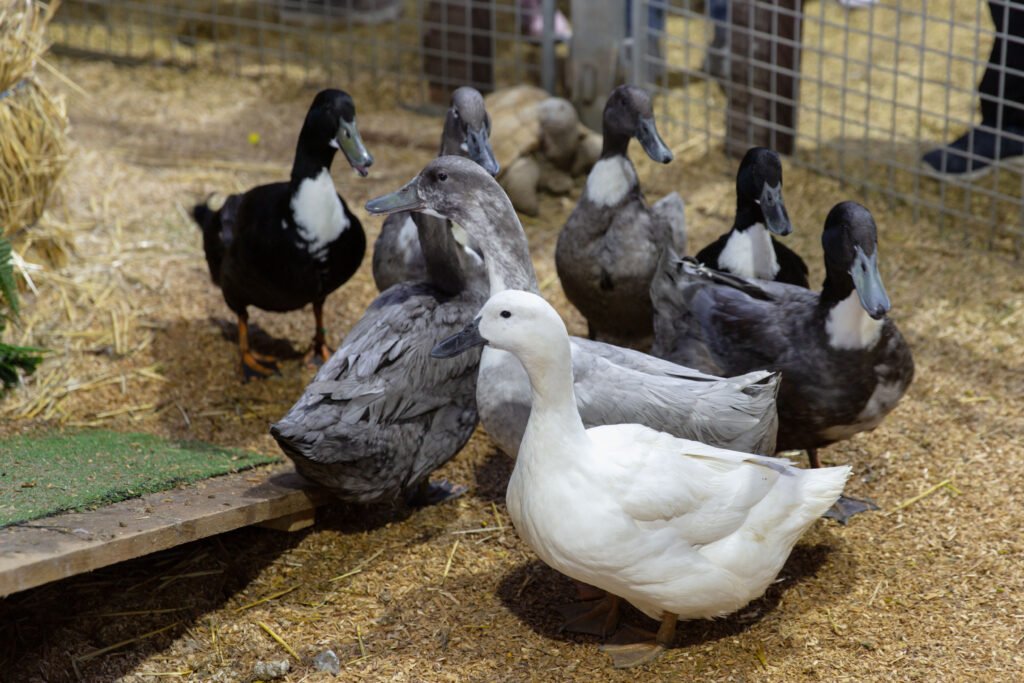
Special Considerations for Pet Owners
Swedish Ducks are a wonderful breed for pet duck keepers, but like any duck, they come with their own set of unique considerations. Their temperament and adaptability make them a great choice for many homes, but it’s important to understand their specific needs to ensure a healthy and fulfilling life for them—and a positive experience for you.
Slow to Mature—In Body and Behavior
Swedish Ducks are slow maturing, both physically and socially. This means:
- They may take longer to reach full adult size, sometimes up to 6–7 months.
- Females often start laying a bit later than other breeds.
- Their personalities continue to develop over time. Young Swedish ducks may seem aloof at first but gradually become more trusting and affectionate with gentle handling.
If you’re used to high-energy, quick-to-bond breeds like Indian Runners or Khakis, the slower pace of the Swedish Duck may feel different—but it’s part of their charm.
Understanding Color Genetics
If you plan to hatch ducklings from Swedish parents, be aware that Blue Swedish ducks don’t breed true to color. Their offspring can come out blue, black, or splash, depending on the combination of parent genetics. This is not a flaw—it’s simply how the dilution gene works in ducks.
It’s a fun surprise for backyard breeders, but if you’re looking for uniformity in your flock’s appearance, it may take some careful planning (or accepting a multicolored crew!).
Not the Best for High Egg Demand
While they are consistent layers, Swedish Ducks are not prolific egg producers. If your main goal is daily egg collection for a large family or small-scale sale, you may want to supplement your flock with a high-laying breed like Khaki Campbells, Golden 300s, or Welsh Harlequins.
That said, many pet duck owners find the Swedish’s moderate laying rate to be perfect: enough eggs to enjoy, without feeling overwhelmed or constantly cleaning out nest boxes.
Great in Mixed Flocks, But Monitor Dynamics
Thanks to their calm and gentle demeanor, Swedish Ducks generally do very well in mixed-breed flocks. However, be aware of the flock dynamics:
- If housed with more dominant or more energetic breeds, like Pekins or Runners, make sure your Swedish Ducks aren’t getting pushed away from food or water.
- Introduce new birds slowly to allow social hierarchies to form peacefully.
- As with all breeds, drakes should be managed carefully, especially if you have a mixed-sex flock. Swedish drakes are typically less aggressive than some, but supervision during breeding season is important.
Low-Maintenance, But Still Need Structure
Swedish Ducks are low-maintenance and beginner-friendly, but they do still need structure:
- A safe, dry shelter to sleep at night and protection from predators
- Daily access to fresh water and quality feed
- Social interaction—either with other ducks or, if raised singly (which we don’t recommend), with human caretakers
Like all ducks, they thrive in routine and benefit from a predictable daily rhythm—feeding, foraging, splashing, and resting.
Swedish Ducks vs. Other Breeds
Swedish Ducks are a versatile and well-rounded breed, but how do they compare to some of the more commonly kept ducks? Whether you’re choosing your very first duck or adding to a mixed flock, understanding how Swedish Ducks differ from other breeds can help you make the right decision.
Compared to Indian Runners, Swedish Ducks are much more laid-back. Runners are known for their energetic personalities and upright posture—they almost look like little penguins running around the yard. While Runner Ducks are prolific egg layers, often producing over 250 eggs a year, they can be quite skittish and require more space to roam. Swedish Ducks, on the other hand, waddle calmly through the day and tend to be less nervous, making them better suited for smaller yards and beginner-friendly flocks.
When it comes to Khaki Campbells, the difference lies mainly in energy and productivity. Khakis are excellent egg producers and are a favorite among those who want a steady supply of duck eggs. However, they’re more active and curious, sometimes bordering on high-strung if not given enough space and stimulation. Swedish Ducks produce fewer eggs—typically around 100 to 180 a year—but they make up for it with a calmer demeanor and a more ornamental appearance, especially in the blue or splash varieties.
Cayuga Ducks share a similar temperament with Swedish Ducks. Both breeds are generally quiet, gentle, and a bit reserved. Where they differ is in appearance and egg color. Cayugas are known for their glossy, all-black feathers with a beetle-green sheen and their unique dark-colored eggs that lighten through the season. Swedish Ducks are more variable in color due to their genetics, producing blue, black, and splash ducklings—even from the same pair. If you enjoy a bit of surprise in your flock’s appearance, Swedish Ducks are a fun option.
Pekin Ducks are among the most popular ducks in the U.S., especially for meat production, but they are quite different from Swedish Ducks in terms of size and care needs. Pekins are large, fast-growing, and outgoing. They’re often the first duck breed people encounter, but their size can lead to leg problems and mobility issues, especially in “Jumbo” strains. Swedish Ducks are smaller and slower to mature but have fewer weight-related health problems. They’re also generally quieter and more independent, whereas Pekins often demand more interaction and attention.
In summary, Swedish Ducks may not outshine other breeds in a single category like egg production or meat yield, but they offer a balanced combination of traits that make them especially well-suited to pet homes. Their calm nature, hardiness, and beautiful plumage make them a joy to care for—especially for those who value companionship and a visually diverse flock over sheer productivity.
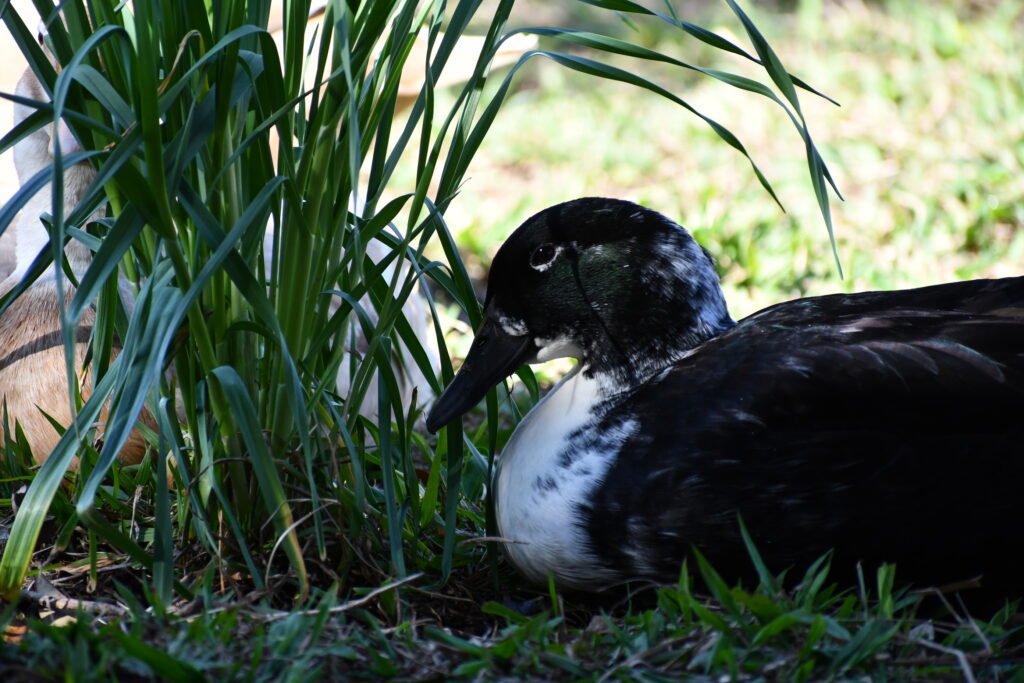
Frequently Asked Questions (FAQ)
Q: Do Swedish Ducks fly?
Not really. Swedish Ducks are too heavy to achieve sustained flight, though they may flap and hop short distances when startled. In most backyard settings, a simple 2- to 3-foot fence is enough to keep them safely contained. Clipping wings is generally unnecessary for this breed.
Q: Are Swedish Ducks good for beginners?
Yes! Swedish Ducks are an excellent choice for new duck keepers. They’re hardy, calm, and relatively low-maintenance. Their moderate egg production and adaptable temperament make them easy to manage, even for those with limited experience.
Q: What kind of eggs do Swedish Ducks lay?
Swedish Ducks lay white to cream-colored eggs, occasionally with a slight blue or green tint early in the season. The eggs are typically medium to large in size and have strong shells, making them ideal for both eating and baking.
Q: Do Swedish Ducks get along with other duck breeds?
Yes, they usually do very well in mixed flocks. Their calm, non-aggressive nature makes them compatible with both active and mellow breeds. However, as with any multi-breed flock, it’s best to monitor interactions and introduce new birds gradually.
Q: How can I tell what color ducklings I’ll get?
Swedish Ducks don’t breed true to color. If you breed two Blue Swedish ducks together, you can expect approximately:
- 50% Blue ducklings
- 25% Black ducklings
- 25% Splash (light-colored, mottled) ducklings
If you’re aiming for specific colors, you’ll need to carefully select parent pairings.
Q: Are Swedish Ducks loud?
Swedish Ducks are quieter than many other breeds. While hens will quack, their voices are typically softer and less frequent than more vocal breeds like Pekins or Campbells. Drakes are even quieter, producing a raspy, low-pitched sound.
Q: How long do Swedish Ducks live?
With proper care, Swedish Ducks can live 8 to 12 years, especially when kept as pets in safe, well-managed environments. Good nutrition, predator protection, and regular health checks all contribute to their longevity.
Q: Are Swedish Ducks good mothers?
They can be, but broodiness is only occasional. Some hens will sit on a nest and raise ducklings successfully, while others may not show much interest. If you’re interested in hatching ducklings, you may want to consider using an incubator or a more broody breed to help.
Final Thoughts
Swedish Ducks are a true gem in the world of pet duck keeping. They might not be the flashiest or the most prolific layers, but what they offer is something even more valuable—gentle companionship, visual charm, and dependable hardiness. Their calm and friendly nature makes them ideal for first-time duck owners, families with children, or anyone looking to add a peaceful presence to a mixed flock.
Their stunning blue, black, and splash feather patterns, paired with the signature white bib, give each duck its own unique look. And while their color genetics can be a bit unpredictable, that’s also part of what makes raising Swedish Ducks so rewarding—you never know exactly what you’ll get, but you’re sure to end up with something beautiful.
They thrive in cold climates, tolerate heat with the right care, and fit in well with both active and relaxed duck breeds. Whether you’re drawn to their heritage, their quiet demeanor, or their resilience, Swedish Ducks are a wonderful reminder that sometimes the best breeds aren’t the ones that do everything the fastest—but the ones that fit seamlessly into our lives and routines.
If you’re considering adding Swedish Ducks to your flock, we think you’ll find them as delightful and dependable as we have. And if you already keep them, we’d love to hear about your experience—share your stories in the comments or tag us on Instagram @ducks_of_providence!
Other Breeds
- Cayuga Ducks: The Beautiful Black Duck Breed
- Ancona Duck – A Rare Duck Breed
- Muscovy Ducks: The Gentle Giants of the Duck World
- Welsh Harlequin Duck – Friendly, Hardy, and Stunningly Unique
- Khaki Campbell: The Champion Egg Layer That Can (Almost) Fly
- Crested Ducks: Pets with a Genetic Defect
- Indian Runner Ducks: The Upright, Active, and Entertaining Breed
- Pekin Ducks: The Classic Backyard Companion
- Silver Appleyard Ducks: The Beautiful Heavyweight Champions of Egg Production

